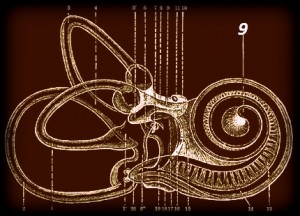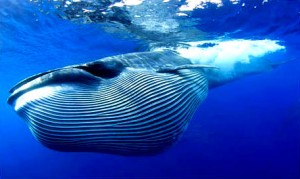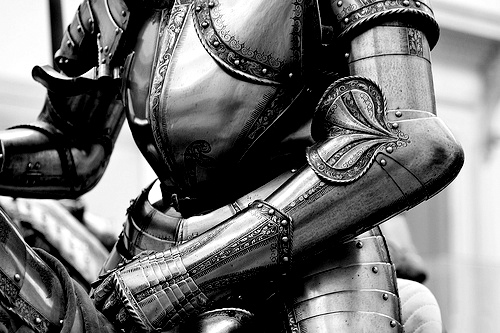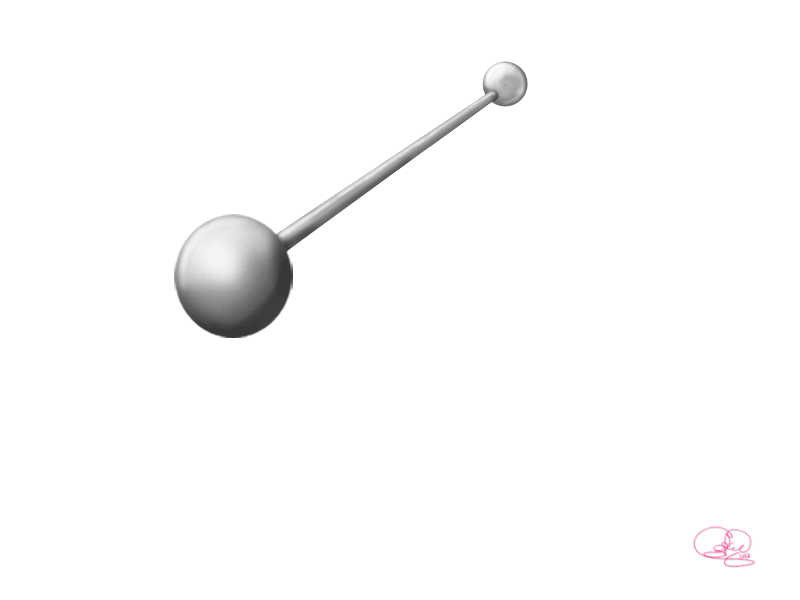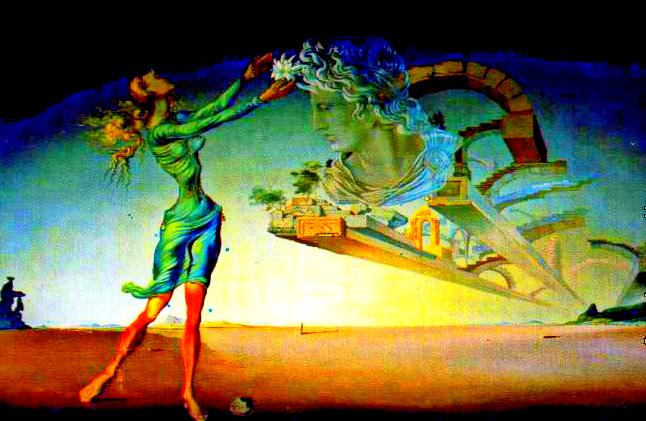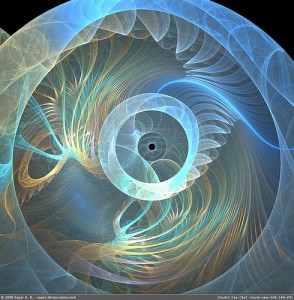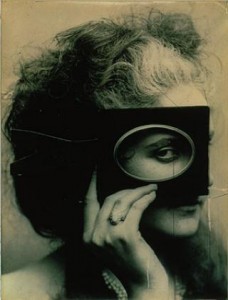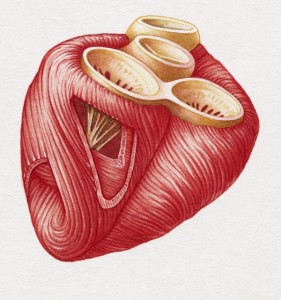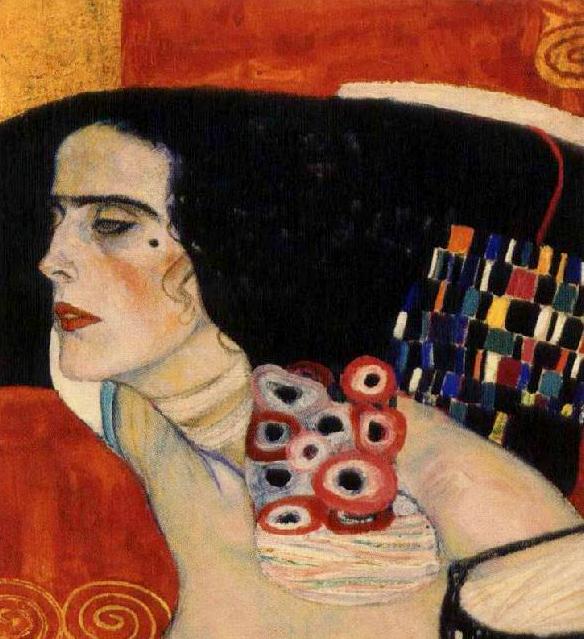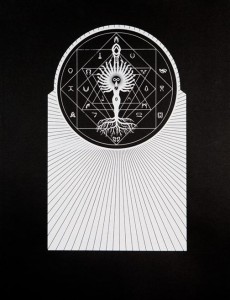The Types
◊ ◊ ◊ ◊ ◊ ◊ ◊ ◊ ◊
♦ Note that these descriptions are unusual angles on each of the Types, and do not include standard introductory information. The purpose here is to illuminate some of the more hidden underlying processes at play; that the multitude of possible inner and outer manifestations of a given Type can be understood from a view closer to the root source, and from acquiring some visceral sense of their energetic imprints as unique signatures unto themselves. To gain an introductory sense of the Types, there are numerous books on the subject, as well as other resources available online.
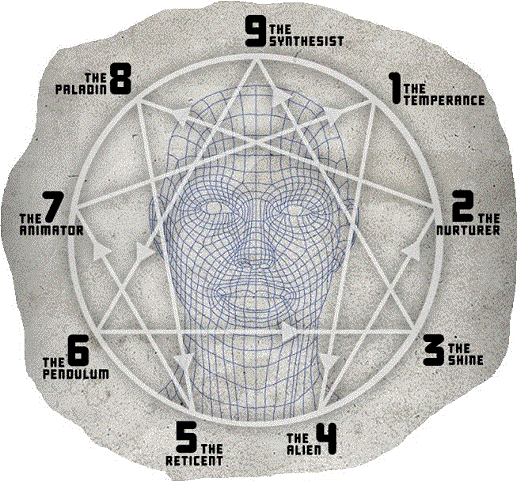
E9 : The Synthesist
At a deeply unconscious level, Type 9 is overly identified with the body. Specifically, the body as a listening device. And just as one role of the human inner ear is to maintain balance, 9s are continually gauging, re-aligning and adjusting internally (at some stratum of psyche) in an attempt to preserve a sense of equilibrium. Emotions that arise upon sensing a disruption in the environmental field register as sensate impressions in the body (or in the etheric/emotional body), analogous to a whale or dolphin using sonar to feel out their surroundings — the sound waves return from an object and flush through the torso, affecting the listener sensually with articulated shape-impressions.
This isn’t to say that people of other types can’t experience something similar, but there’s an oversensitivity in this type — too much attention placed on degrees of balance, an overemphasis on aligning with some esoteric set of kinesthetic meridians. Even subtle increments of incongruity or discordance can raise an alert status as a felt sensation — if only registering subconsciously. Still, some kind of movement or adjustment will have to take place. Disturbing stimuli (‘sharp shapes’ pinging off of someone else’s emotional state, for example) are things to be calmed or placated or avoided and forgotten so as to re-right the course and resume a desired state of body equilibrium.
On another level though, E9, as resident of the Gut triad, has a significant underlying compulsion toward self-reliance/autonomy — the very opposite of all this adjusting and maneuvering to make things OK in their surroundings. So the Gut’s independence streak is continually contributing to some backlog of rebellion and resistance to the concurrent program of appeasing the environment. This is where stubbornness comes in as a strategy. Since direct expression of aggression is largely verboten in this type, a significant portion of 9’s repressed defiance and friction finds safe expression in becoming an immovable object — a thousand pound boulder that can’t be budged in relation to certain issues or beliefs or circumstances.
This association of E9 with the ear follows through, metaphorically, when we notice that the resistance mentioned above, manifests often in the form of not-listening. And on a deeper level, we’d say Type 9 has an unusual capacity for denial, which is a kind of resistance to hearing a given truth, internally. An inner deafness.
Ω Ω Ω Ω
E8 : The Paladin
From one angle, Eightness is similar to being a large animal that has no concept of its size. It traipses through your living room, tail knocking over your Ming vase on the way through, misjudging the width of your door frame — *smash* — and there they go, still moving, passing through, oblivious to much of their effect on the environment/people/objects. *clonk, clonk*
This quality of not-knowing-its-size is one reason why some 8s have initial trouble typing themselves — they project that everyone else is an equally big animal or has a similar self-concept. Their prime projection — it’s a jungle out there — keeps the underlying program-of-personal-size in full swing. Worth noting here, too, that E8 is the universal prototype for masculinity and machismo, so male 8s often end up exhibiting some of the more exaggerated versions of this fixation due to the considerable leverage of cultural/familial support for this style, which can begin fostering the characteristic repression-of-vulnerability in earliest childhood in the life an individual 8.
The point about the association of Type 8 with masculinity/machismo is also mentioned for those who may have been raised in circumstances where 8-ness (aggression/strength/vulnerability-suppression) was particularly valued (or over-valued), as this may lead to mistypings. Conversely, in their developmental stages, girls are given much more permission to express sensitivity, and hence female 8s can have some trouble seeing themselves in the descriptions of this type. Stated another way, this psychological style is phallic, so the female iterations of this type are sometimes less pronounced or less stereotypically aggressive.
An apt title for this type is “Anger instead of vulnerability”. From one perspective, 8s can be described as mistreating themselves, unconsciously, by denying their vulnerability. Rage is the substrate material of the Gut types (8, 9, 1), and they use it (unconsciously) to mobilize the will to repress whole large chunks of psyche. From E8’s perspective, the prime imperative is that sensitivity and vulnerability be pushed away into perfect non-existence. Of course, the Gut’s attempts at implementing such massive hemispheric repressions are ultimately untenable and doomed to failure…but the ideal remains a constant and there’s much more success here at such denial (a kind of willed blindness) than can be pulled off by the Head and Heart types.
This idea becomes illuminated when considering the metaphor of the Gut as a sensory device…or more to the point, when contrasting in symbolic space how many of the five senses are located in the Head, and considering the Heart’s capacity for subtle receptivity and intricate reactivity. Comparatively, the Gut is flying blind in the subterranean. Gut instinct / gut response is to “know” and take action from a primordial space of pre-Thought/pre-Feeling, if you will. An underlying consciousness that’s localized in the Gut implies a psyche working with bigger and more raw chunks of psychic material, less undermined and impeded by the granularity of the Head and the spindly tuning of the Heart…and is therefore, among other things, less hamstrung in the progress toward its neurotic goals of self-repression, targeted at specific areas of psyche, per each Gut types’ inherent bias.
Anger-instead-of-vulnerability has 8s taking revenge on the World in some way, because in order to be strong, the Eight has sold his/her innocence to the Devil, so to speak, and the World has to pay for that sacrifice. Because they feel they had to offer up their innocence (weakness, neediness, submissiveness, susceptibility to feelings of guilt), if anyone appears as an opponent, it becomes a matter of justice to the 8 to confront and punish, partly in retribution for the 8’s killing of their own vulnerability.
Moving about in the world, 8s are mainly unconscious thinkers. They’re instinctively counterphobic, as compared to E6’s more conscious counterphobia. Thinking about oneself and one’s worries is largely in the subconscious, or perhaps is the work of the reptilian/mammalian brain in 8s. Compared to the other types, their fears are generated less by conscious thought; fears here are mostly instinctual, less susceptible to influence by rational deliberation.
Become a Patron!
Ω Ω Ω Ω
E6 : The Pendulum
Type 6 may be the most difficult type to convey succinctly and comprehensively, partly because, compared to the other types, it straddles the widest polarity of opposing realities. And no less confounding is how evenly split this self-bifurcation is: essentially, exactly 50/50.
All the types are mechanistic – able to be conceived of and visualized, in the abstract, each as their own integrated arrangement of inner gears, pulleys, levers, a simple motor, if you will, each part representing the major building blocks of psyche: ego, superego, id, the Centers (Head, Heart, Gut) and so on, interlaced perhaps by a connective belt of influence, producing each Type’s stylized dynamic of intrapsychic movement. The Six mechanism is perhaps a rather simple structural form, with a central component built largely around a two-dimensional polarity, connected by a single straight line, but this form paradoxically generates a greatly contrasting palette of possible manifestations of the 6 fixation in individual Sixes, one to the others, and even within a single individual.
This type is the spirit of contradiction, through and through. Any and all traits that we might assign to it, we’d have to include each and every opposite as well, with essentially no exceptions. Rather than viewing E6, though, as a catch-all allowing us to throw people into the Six bin who are otherwise difficult to type, this characteristic (structural) block in accessing the integrated middle, itself, draws a significant contrast between this type and the rest, and will therefore assist in spotting the type in ourselves and others.
This emphasis on opposites may seem like overkill, but before we leave it, consider the concept in terms of 6’s relationship to 9: viewing it from the perspective of the central Enneagrammic building block — the number 3 — Type 6 is two opposing 3s, while 9 adds a third 3, the neutralizing agent, the integrative function, or (on the low side) having a dispersive role. In further contrast, look at 6’s other cousin, Type 3, where we see the more single-mindedness (uni-directionality) of a single 3. And further, we might say, in the abstract, that a Nine “was a Six in his past life”, which explains the Nine’s prime imperative to solve the opposition, apparently overly guarded against the re-emergence of his past conflicted self.
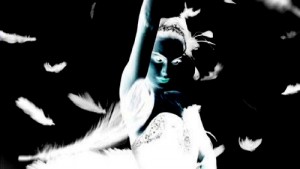

In the context of understanding all the types – and understanding human nature – Six becomes important because it’s particularly archetypal to the human dilemma, i.e.- this quality of bifurcating everything (into good/bad, right/wrong, true/false, real/unreal) is a universal condition; it undercuts our endeavors and thoughts, in people of all types. The divided self, the antagonist within, the split will, indecision, questioning. Six is the typological personification of Light and Shadow, a living incarnation of our fundamental disunity and crisis of faith, unable to locate the direct intuitive channel to Source, the plug into firsthand understanding of our purpose and meaning. Unsure whether the Universe is friend or foe.
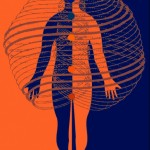 A natural fallout from this fundamental precariousness – at a cellular level of psyche – is the Grid, a compulsion to set an abstract latticework, a hard logical reinforcement, across the canvas of the random universe. This can take on many forms: from religion to astrology, which both set a static graph in the sky, to law and psychology, which have their precedents and systems, definitions and schools of thought, a compulsion toward abstract seizure and control of the chaos of human nature through delineation in mental space. For some 6s, this takes the form of looking to established authorities. For others, the process is much more abstract and solitary, yet still having a tendency to favor man-made structures.
A natural fallout from this fundamental precariousness – at a cellular level of psyche – is the Grid, a compulsion to set an abstract latticework, a hard logical reinforcement, across the canvas of the random universe. This can take on many forms: from religion to astrology, which both set a static graph in the sky, to law and psychology, which have their precedents and systems, definitions and schools of thought, a compulsion toward abstract seizure and control of the chaos of human nature through delineation in mental space. For some 6s, this takes the form of looking to established authorities. For others, the process is much more abstract and solitary, yet still having a tendency to favor man-made structures.
Ω Ω Ω Ω
E2 : The Nurturer
Proffering motherly attention in search of the inverse
Imagine Type 2 as having come into this world catalyzed around a particular aspect of the mother-infant archetypal relationship: the predisposition of the infant Two is toward a powerful conflation of the lovelocked gaze of their mother during nursing with the act of nursing, itself. This forms a broad preoccupation with nurturance, which can actuate in both literal and figurative (emotional) feeding, but food and even nurturance aren’t the thing; reciprocal adoration is the key, the earliest form of mirroring.
There’s a mutual romance here – Mother shares her body as a love object, a warm edematous pillow of holding, and surely something stirs for Her as we drink. To the infant, a nonverbal quasi-erotic promise of ownership is given in this field: I am Yours, and You are Mine, Forever. The sensation of the gaze, the holding, this tactile libidinized connection – the Two, in particular, mistakes these for who they are as a person, and when the sensation is broken there’s a feeling of no longer having a self (ego-flat, as it’s been called). And since the adult Two only ever experienced the idyllic version of this Love sensation as a participant in the hyper-personal mother-infant field, they perceive that the only place to get it back would be within the similar special space of unusually close relationships with other people.
Life then becomes a quest to become that important again to someone, and to people in general. Hence, Two’s classical association with the sin of Pride; which can be understood, at least partly, as the ego’s attempt to reproduce the sensations, feelings, vibrations of the early mother-infant relational circle. But descriptions of E2 typically correlate this type with the mothering role, not with living out an Infant motif. An explanation for the switch-up is that, at an initial stage when Mother is beginning to foster the infant’s individuation and separation, the infant Two’s reaction to the loss of the idyllic state is defiance, a precocious and swift rejection of Mother in response to the betrayal of not remaining in the worshipful state of the mother-infant bond. “You’re supposed to love and adore me; that’s what Other does.”
Such an ultimate betrayal inspires an ultimate response: in the basement of the Family’s psychic home, the child snatches the Mother badge for itself, and sets out to do mothering ‘the right way’, but always with the goal of somehow being rewarded with re-admission into Paradise. And Paradise is the infant role. Self-infantilization can be seen in the way famously overbearing Twos become substantially at the mercy of those they want love from. Two’s psychological growth then is that of a newborn discovering other things in life besides the covert romances they’ve cultivated, finding an identity bigger than just the sensation of gaining that esteem with the targeted Someone.
Two’s Pride is often described as having an underlying sense of entitlement for having served others in some way; they’ve earned it, in other words. But if Pride were distilled down to its full potency, its essence would be revealed as “I’m entitled, period. Because I exist.” Going back, again, to the newborn’s preconceptual narcissistic field of adoration: at an unconscious level, Pride assumes (for Itself) the existence of a pledge, that “this is the way things are supposed to be”, i.e.- the Two should exist in a sanctuary of love, nurturance and adoration. But subsequently “Mom betrayed me by depriving me of it.” The demanding nature of entitlement (guilt trips and manipulation seen in Twos) then reflects the power dynamic of the Rejection types (2, 5, 8), in this case believing that the Other (whomever the Two is in close relations with) is inherently obligated.
At a semi-conscious level, the Two attempts to bring to the surface this sense of obligation that they believe exists somewhere in the other person. The Two’s efforts to earn love and appreciation are intended to amp up the other person’s sense of their own innate indebtedness to the Two, since the other is evidently blind to their obligation, as evidenced by Utopia’s failure to re-emerge. Pride says that the other person’s duty to love the Two is simply part of Nature; but since the Other isn’t ever quite getting right, in the idyllic sense, or they’re sometimes withdrawing or pulling it away, Twos feel the need to magnify the Other’s obligation to the point where they’ll become aware of it. Hence, the underlying manipulative power dynamic; making Other corroborate what Nature decreed as Two’s birthright.
Coming back to the (figurative) formative stage, what naturally falls out from Two’s defiance and turnabout in relation to Mother is a re-orientation toward Father. This new direction becomes an assertive mission of re-unification with the Intimate Other dynamic, a private and closed electrical circuit, with the Two offering some ultimate feminine/nurturing charge as seductive receptor for the opposite polarity of the masculine/father charge; the Two actively urging and inviting the plug that will light up Shangri-La once more. Thus, hijacking father from mother; spawning a triangulation pattern, a pride-based competition with Mother for the prize of most loving and nurturing.
* As alluded to at the start, the above described infant-mother dynamic (and permutations therefrom) isn’t to be considered as having formed or placed the Type structure within Twos – it’s not a literal story of how people become this type – but is an abstraction to gain insight into the Type’s elemental design.
Ω Ω Ω Ω
E1 : The Temperance
4 ↔ 1 ↔ 7
(inner) Dionysian psychic violence (E4) + (outer) Bacchanalian sensual stimulation (E7) = sobriety/principles as a solution (E1)

Looking at the connecting lines, we can see that the abstraction that is Type 1 comes into being between 7 and 4; two significantly irrational energies which make up a manic-depressive polarity: 7 = manic, 4 = depressive. These both also have a manic-depressive polarity within each of their own structural confines, unto themselves. Erratic molecules made up of erratic atoms.
There’s a spirit of chemical disturbance, you might say, an unbridled voltaic fluidity flying around as you work with these two in abstract space — 7 as overactive Head, and 4 throwing gasoline on the Heart fire — a psychological storm is brewing. When brought into the same primordial elemental field as disembodied raw energies, a certain dissonant buzz ramps up quickly, the walls start to bend around us…a firm sense of One-ness becomes the imperative and only hope. This is the unholy ground, between Satyr and the indulgent Flaw, where E1’s reaction-formation begins and quickly crystallizes.
Type One is duty-bound to catalyze here, a firm Apollonian correction of straight tempered metal verticalness – “1” – the noble dividing line between the 4/7 confluence. Reason and Temperance and Eternal Principles enter the theater; the uncanny cacophony stops.
With E1 on the scene, the 1-4-7 group now forms an equilateral triangle: another symbolic allusion to E1′s design to bring perfection of order & equilibrium to a frustrated table. Good luck.
Ω Ω Ω Ω
E7 : The Animator
Keep Running / ‘snap architecture’
Considering E7 as member of the Head triad, there’s to notice the symbolism in its abutment to the Gut Center. Drawing a comparison, E5 as a Thinking style could be described as granular, while the Gut can be viewed as big-block knowing, à la gut instinct, where the granular is leapt over, into rock-like certainty (for better or for worse), where sureness is pre-verbal, pre-thought. In fact, to set them in sharper relief, it could be said that the Gut’s brand of knowing has a quality, tonally-speaking, of having occurred in some ancient space, many thousands of years ago, having visceral connections to the basic building blocks of psyche and existence. And getting back to 7, specifically, looking at its connecting lines, 7 is the only one of the Head types that doesn’t have as its higher goal to integrate to the Gut (i.e.- 5 goes to 8, and 6 goes to 9 to elevate in psychological health).
Positioned where it is on the enneagram, 7 then absorbs some magnetic energy from the Gut, and since 7 is a Head type, this combination (head + gut) is saying something about the materials and the speed of thought: from this mental space, tall edifices rocket up from bigger hunks of mass, immediate manufacture and formation. No tiny seedlings here; the instant orange tree complete. Snap architecture. In contrast to 5 and 6, stacking up one factoid brick at a time. This is the archetype from which comedy, wit and ambidextrous whimsy spring; musical intuition and visionary planning too. We’re now well around the wheel away from the shrinking anemia and debilitating ‘Hamlet problem’ of the Existentialist gap between 4 and 5; the 7 reflex is toward externalization, manifestation, literalize the vision, “Don’t dream it. Be it.”
On the other side of this double-edged sword of holiday symphony synaptic sparks, however, is the fast fade; if the physical prototype doesn’t instantly spring into being within a short expanse, Hermes flits on to the next interesting thing that launches from the architectural wellspring. Time moves faster here, a minute ago is yesterday. A mental castle was built, kings and queens glittered gold, history already passed through these halls, and throngs of modern tourists bought the t-shirt on the way out the door. Now what??
Ω Ω Ω Ω
E5 : The Reticent
Way up in the small left-hand corner of the head, observing chaos
The ennea-symbol, itself, provides a couple of insights into the cosmogony of Type 5. Considering the connecting lines – 5 has a line to 7 in one direction, and 8 in the other — 5 sits between 7 and 8, from one perspective. And these two types (7 and 8), as a general energetic character trait, exhibit ‘Big Me’-ness, each filling up a large amount of space with their personalities. So the compression that ‘fetus 5’ experienced during its primordial gestation left it with essentially no room for physical existence; its only recourse was to take up residence mainly in abstract space, in the setting of the mind, significantly shoved out from corporeal existence by these two Jupiters.
The second metaphorical insight provided by the e-symbol: Imagine now, that 5 is born and shot downward to its permanent homepoint, to what’s been called the Existential Gap, at the bottom of the Enneagram. This continues the theme of questioning physical existence and participation. The space between 5 and 4 is the flaw in the Enneagram’s otherwise closed star-crystal. The fracture where the status quo is broken and progressive consciousness enters the human domain. The acute angles of the connecting lines to E5 and E4 allude to a severe dilemma being chewed on down here. Fangs sunk deep into abstract meat.
5 then sits at the precipice of our earthly condition, uncertain about whether to show up and participate…or maybe simply observe the goings-on inside the (ennea-) circle of humanity, and then turn the other way to stare out the window (out the gap) into conceptual space, into things beyond current human reality.
Ω Ω Ω Ω
E3 : The Shine
A seemingly-wet surface that turns out to be hard when touched
Using simple math for symbolic purposes, if E6 is two opposing 3s – perfect ambivalence – the single cell of 3 (the basic building block of the enneagram), embodied in Type 3, shows up what could be viewed as an advantage of simplicity and self-unity as a characteristic of this type’s underlying program. A capacity for singularity of thought, purpose and action. As contrasted with Cousin 6’s structural self-division, 3’s structural unilateralism brings a certain holistic resilience to the type’s characteristic self-hypnosis – all the Types being a self-hypnosis of sorts. In archetypal space, the number 3 also aligns conceptually with the triumvirate qualities of masculine, feminine and their integrated byproduct – a neutral integrative function.
So, there’s a solipsistic and androgynous quality about the construction materials of this Type’s architecture. The metaphoric triune has a capacity for asexual reproduction. The thing complete. This isn’t to say that E3, as a type, actually is self-unified or self-possessed, through and through, or that individual people of this Type are such – in fact, as a member of the Attachment group (3-6-9) this type is picking up outside influences on a regular basis – the idea here, though, is about a relative smoothness of actualization, a cohesive mobilization of the fixation’s interest to produce/perform. The description here is still about a form of neurosis, but the point is about the contrast in how pared down the fixation is in terms of diversions compared to the counter-forces that we could point out in most of the other e-types.
As part of the Heart triad, E3 is assigned the quality of out of touch with Heart; what seems to fill in that space though is the Heart as a muscle, a psyche that has a muscular/athletic quality to it. This is where the common conceptions of E3 as a performance machine arise; which again isn’t the same as saying Threes always performs well. It can mean, hypothetically, that if the mind were set on not performing well, it has significant psychic muscle to carry out the task.
[Tangentially, 3, 6 and 9 all have a characteristic tightness to the grip of their fixation, based on being units of 3. This idea becomes clearer, in symbolic space, if we compare the capacity for construction using equilateral triangles as compared to building with units of the hexagrammic cell structure of the Secondary Types (1, 2, 4, 5, 7, 8). This doesn’t mean that 3s, 6s, and 9s are more fixated than the other types, but they’re caught in a deeper rut, dug by the feedback loop of alliterative 3-based waveforms which continuously ping through the Centers, moving through the connective triangle of the Primary types. The ease with which equilateral triangles align together also speaks to all sides touching all sides, so the perpetual self-redoubling of the fixation is receiving cozy encouragement all around.]
 Starting from the premise that the Enneagram of Personality is a discovered organic reality, if the number 3 is the basic unit of the enneagram – a primary kind of brick used in the construction of the psyche – this is a hint that an understanding of Type 3 will point to universal qualities about the fundamental nature of psyche and Ego. The association of E3 with narcissism, for example: Ego apparently looks at itself as an aesthetic object and is self-conscious about how it appears in others’ eyes, it wants to be recognized for accomplishment, for being special. It has a competitive nature and a particular capacity for self-deceit. Considering the Heart triad also as Image triad, Personality itself is a mask, an image obscuring the real self. A lie, in other words. Nothing new there, but all these things overlap the fundamentals of E3.
Starting from the premise that the Enneagram of Personality is a discovered organic reality, if the number 3 is the basic unit of the enneagram – a primary kind of brick used in the construction of the psyche – this is a hint that an understanding of Type 3 will point to universal qualities about the fundamental nature of psyche and Ego. The association of E3 with narcissism, for example: Ego apparently looks at itself as an aesthetic object and is self-conscious about how it appears in others’ eyes, it wants to be recognized for accomplishment, for being special. It has a competitive nature and a particular capacity for self-deceit. Considering the Heart triad also as Image triad, Personality itself is a mask, an image obscuring the real self. A lie, in other words. Nothing new there, but all these things overlap the fundamentals of E3.
This type is often on the receiving end of a particular negative bias from those that know the Enneagram; all the above may be exactly why – considering that this type is often associated with Deceit, we could state it lyrically, that the overview of E3 reveals something hidden about ourselves and our egos – it’s a lie that tells the truth. And Narcissus doesn’t see only himself in the water; if we fully looked through his eyes, we’d see that his reflection sets him in the sky, among the highest peaks of achievement and glory.
Ω Ω Ω Ω
E4 : The Alien
A core piece of the Type 4 fixation might be conceptualized as an underlying sense that one’s DNA is irreparably broken or fundamentally different; or that it’s different because it’s broken. Imagine a DNA helix that’s much more tightly twisted than others, mangled and distorted. The torsional stress, figuratively, cuts off the intracellular circulation, a significant portion of the flow of intra-helical messages is stalled out, dwindling the Four’s options, rendering them frail in relation to their will to move, to do, to pivot around in corporeal space from the springboard of the Gut. The muscles of outer action appear crippled or built from the wrong stuff, sharply diminished in the number of available moves or opportunities, leaving the Four staggering toward a couch of sighs.
The will, which, among other things, would normally animate the self into literal motion, is largely bled off into subterranean processes, applying its native strength of force and energy to animate the imagination and bring life to chimeras. The arteries of the primeval Gut being rerouted, plunged into the inner landscape, generate Four’s characteristic inner storminess and proneness to psychological violence in multiple forms. The colors of the outside world pale in comparison to the very active crimson stage within.
Meanwhile the twisting snaky gnarl of the DNA string tightens in on itself, bringing itself into contact with another part of itself, face to face in a Hall of Mirrors…an easy place to get lost. This ‘lost’ quality continues the overlap with the fractured DNA blueprint, the perpetual alien gets drawn into the warped hall of self-impressions rather automatically and mechanically. The Land Inside, amongst a population of other distorted reflections of ‘me’, appears as the only place on this Earth that one belongs. “Yesterday, I heard they cloned a baby… Now can I finally sleep with me?”
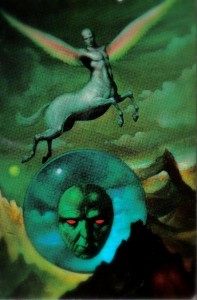 This twist of fate is the blueprint for one of E4’s core dynamics, something that might be described as emotional torquing. To greatly over-generalize for the purpose of illustration, it could be said that the other Types have a 2-dimensional pain schema: here’s the bad thing on one end of a straight line…and on the opposite end, there’s the hurt feeling in response. E4 does a peculiar thing: adds an unexpected and incongruous third dimension – Beauty – into the pain dynamic. An image of an ideal self or place or special Other or outcome or Feeling-state is dangled in front of the inner eye, an elegant paisley-carved carrot on a stick, the Four longing for what’s just out of reach and simultaneously a million miles away. A forceful feat of psychic engineering. A torque dynamic is only possible in 3-dimensional (psychic) space. Twisting and then re-twisting in the other direction to squeeze more bitter juice from the longing, the missing of the missing piece. “Waiting for the present to pass….Waiting for a dream to last”
This twist of fate is the blueprint for one of E4’s core dynamics, something that might be described as emotional torquing. To greatly over-generalize for the purpose of illustration, it could be said that the other Types have a 2-dimensional pain schema: here’s the bad thing on one end of a straight line…and on the opposite end, there’s the hurt feeling in response. E4 does a peculiar thing: adds an unexpected and incongruous third dimension – Beauty – into the pain dynamic. An image of an ideal self or place or special Other or outcome or Feeling-state is dangled in front of the inner eye, an elegant paisley-carved carrot on a stick, the Four longing for what’s just out of reach and simultaneously a million miles away. A forceful feat of psychic engineering. A torque dynamic is only possible in 3-dimensional (psychic) space. Twisting and then re-twisting in the other direction to squeeze more bitter juice from the longing, the missing of the missing piece. “Waiting for the present to pass….Waiting for a dream to last”
Ω Ω Ω Ω
© 2013 David Gray
Become a Patron!

